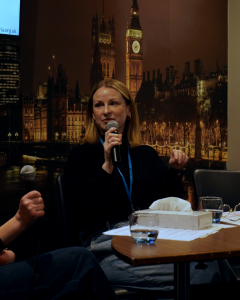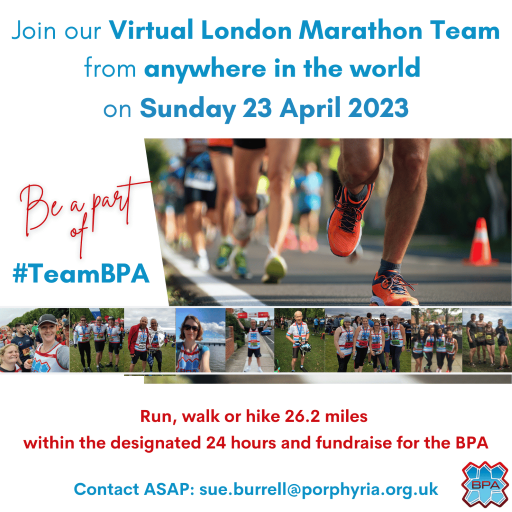Emma Hartley was diagnosed with Acute Intermittent Porphyria (AIP) in 2024 and shared her story with us at the BPA’s Patient Day in London in November 2025. Her experience is an important reminder of how crucial advocacy is when navigating a healthcare system that does not hold enough space for rare disease.
Read her story below, and watch this space for part 2!
***
A year ago, I lay in a hospital bed with pain so excruciating it required morphine, yet the daily focus from doctors was on discharge without a diagnosis. When I reflect on that time, one question keeps coming to mind: What would have happened without the village of people that advocated and acted for me?
My diagnosis took a relatively short time compared to other patients with the same condition, but it was very nearly too long.
Acute Intermittent Porphyria (AIP)
The key themes of my experience may resonate with a wide range of rare or complex disease patients, but for context I was eventually diagnosed with Acute Intermittent Porphyria (AIP).
AIP is a rare inherited metabolic disorder that disrupts the body’s process for making heme, leading to a toxic buildup of chemicals (porphyrin precursors). While it is estimated 1 in 2000 people in Europe have the faulty gene, only a small number ever go on to be symptomatic, even fewer have multiple attacks.
Attacks are thought to be triggered by things like stress, infections, certain medications and hormone shifts. Accumulation of neurotoxins in the body leads to symptoms such as severe but vague abdominal pain, muscle weakness and psychiatric symptoms. These can progress to paralysis, seizures and in some cases, death.
The subtle start
My symptoms began subtly last summer – an intermittent backache I mistook for period pain or poor posture. In November, things ramped up to include severe nausea and abdominal pain until I couldn’t sleep, work, or participate in family life.
Even at this point, I tried to convince myself it wasn’t serious. I thought it could be an IBS flare-up, with the pharmacist and GP agreeing that the pattern of symptoms didn’t fit any other obvious condition. Eventually, pacing the house in agony and starting to vomit, I knew I had to go to A&E.
I presented badly enough (something from ‘The Walking Dead’, my husband kindly tells me) to be fast-tracked through to triage, but things stalled when I got to the surgical ward. CT and ultrasound scans searching for signs of more common causes, such as gall stones, ectopic pregnancy or appendicitis, all came back clear.
Feeling unheard
Despite clear signs of deterioration – increasing pain, confusion, hallucinations, vomiting, rising blood pressure, difficulty with my eyesight and even facial twitching – the daily focus from the doctors was on discharge without a diagnosis to explain it. My family desperately asked for a second opinion or a transfer from the surgical ward to a medical ward. We were denied.
I recall hearing one doctor say “some people just have to live with pain”.
This response was devastating and felt like a lack of medical curiosity, an unwillingness to seek advice from elsewhere, and a dismissal of symptoms amounting to medical gaslighting.
The recent push for Martha’s Rule – which recognises that those who know the patient best may be the first to notice signs of deterioration – would grant patients and their families the right to a review from a different team if they feel their concerns are being dismissed. This is a crucial step to ensuring no one has the same experience as us.
The breakthrough
What saved my life was a village of advocacy and the sheer determination of family, friends, and professionals who refused to accept “I don’t know” as the final answer.
My husband was relentless at my bedside, demanding blood tests that had been promised and not taken, and pushing for a plan that didn’t involve discharge without resolution. My parents sat by my side, bringing me ‘contraband’ hot water bottles to ease the pain and encouraging me to eat, drink and move to prevent further deterioration.
My sister, a healthcare professional, was encouraged by ward staff to leverage her own network. She posted my symptoms to a private WhatsApp group of local doctor mums and the collective brainpower was immense. Suggestions, support and curiosity came pouring in.
The first mention of porphyria came from this group based on the vague acute abdominal pain alongside a normal CT scan.
Crucially, two additional clues – my urine turning red and my sodium level plummeting – gave this theory momentum. My sister made contact with the National Acute Porphyria Service (NAPS) to seek advice but could only get so far without a hospital referral.
When my sodium dropped to a life-threatening 105mmol/L an on-call medic, initially alerted by the informal network of doctor mums, escalated my case to the Intensive Care Unit (ICU) team. A metabolic specialist, a contact of my sister’s friend, cycled over in the snow late at night to provide additional advocacy. I also recall him excitedly searching for a UV light to see if my urine ‘glowed’ (the accumulation of porphyrins causes fluorescence).
In the ICU, the medical team listened to the detailed medical history my sister was able to provide and they made contact with NAPS. I was started on treatment (haem arginate) that night and by morning I had a diagnosis of Acute Intermittent Porphyria confirmed.
As terrifying as it is to need to be on a critical care ward, for my family there was a profound sense of relief. They were being heard. I was being rigorously monitored, we had a diagnosis and I was receiving the life-saving treatment I desperately needed.
In my next article I would like to reflect on the hidden mental health toll of living with a rare disease. I hope this will resonate with and offer insight to rare disease patients, their families, and the medical community.






